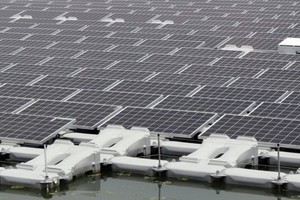
Ever since Japan’s Fukushima Daiichi plant was destroyed by a combined earthquake and tsunami, the country has been faced with a significant shortage of generating power. In the short term, Japan ramped up its reliance on coal and liquefied natural gas, and instituted electricity rationing and asked consumers to cut their consumption by 15%.

Advocates of green power have called for the deployment of additional wind and solar power generators, but both have been limited by Japan’s small land area. Limited space for power generation has led the country to look elsewhere, including deploying a technology called floating solar.
Floating power generation is arguably more important to Japan than virtually any other first-world nation. While it doesn’t have the highest largest coast/area ratio in the world, the nations that surpass it, like Denmark, with a ratio of 125, it combines a high ratio of 79.6 with high population density and a fully modern, industrialized economy. This combination puts enormous pressure on Japan to make full use of every scrap of available land — or inland water source.
Techon reports that Kyocera Communications Systems has paid for the installation of a new floating solar plant, dubbed Sakasamaike. The article steps through the construction of a floating solar plant and the unique technology required to bring it online. Workers first assemble scaffolding before deploying pre-constructed “floats” that support the solar panel and its wiring and infrastructure. All told, Kyocera deployed 9,072 solar panels on the pond’s surface and laid resin-coated pipes to preserve the internal cable that stretches from the installation back to shore. The pipes are designed to float if they remain water-tight, giving inspectors an easy way to determine if a pipe has been breached or not.

The floating cables are arranged in straight-line configurations to pipe power back to ground-based collection stations, with a maximum cable length of 400 meters. Several criteria have to be met in order for pond installation to proceed, according to the article. Ponds need to have a uniform depth, shouldn’t be too deep in the first place, (10-15 feet is apparently ideal) and have a bank that can support the scaffolding construction required to deploy the boats and floating solar arrays.
Cost is apparently nearly identical to ground-based solar, but there are still challenges related to retrieving parts if dropped into the lake, and the need for on-site diving teams to anchor the floats and link them to the rest of the grid. Total deployment time is only slightly higher than ground-based solar, and there are advantages as well — floating solar plants are easier to cool since the water in the pond soaks up heat, while simultaneously shading the water from direct sunlight. While the solar arrays still produce heat of their own, the shade effect is apparently greater than the indirect heating — water temperatures tend to cool after arrays are installed, which inhibits algae growth.
The price of PV installations has dropped dramatically in recent years as Japan has ramped up its installation of both solar and wind facilities. The country has begun testing offshore wind development near Fukushima itself, and we could see solar power deployed in bays or coves as well in coming years — provided companies can come up with a method of dealing with the corrosive effects of seawater and the need to clean the panels on a regular basis. Making use of Japan’s shoreline is likely key to the island nation’s power generation in the future.
Source:
By Joel Hruska on July 27, 2015
